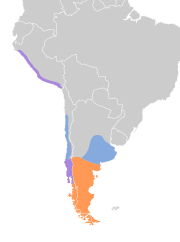Theristicus
Appearance
| Theristicus | |
|---|---|

| |
| Black-faced ibis. | |
| Scientific classification | |
| Domain: | Eukaryota |
| Kingdom: | Animalia |
| Phylum: | Chordata |
| Class: | Aves |
| Order: | Pelecaniformes |
| Family: | Threskiornithidae |
| Subfamily: | Threskiornithinae |
| Genus: | Theristicus Wagler, 1832 |
| Type species | |
| Tantalus melanopis Gmelin, 1789
| |
Theristicus is a genus of birds in the family Threskiornithidae. They are found in open, grassy habitats in South America. All have a long, decurved dark bill, relatively short reddish legs that do not extend beyond the tail in flight (unlike e.g. Eudocimus and Plegadis), and at least the back is grey.
Taxonomy
[edit]The genus Theristicus was erected by the German naturalist Johann Georg Wagler in 1832 with the black-faced ibis as the type species.[1][2] The name is from the Ancient Greek theristikos meaning "of reaping".[3] The genus contains four species.[4]
| Common name | Scientific name and subspecies | Range | Size and ecology | IUCN status and estimated population |
|---|---|---|---|---|
| Plumbeous ibis | Theristicus caerulescens (Vieillot, 1817) |
south-western Brazil, especially in southern Mato Grosso and Rio Grande do Sul; Paraguay, especially in the Chaco and in the Paraguayan section of the Parana Basin; Uruguay; north-eastern Argentina and northern and eastern Bolivia
|
Size: Habitat: Diet: |
LC
|
| Buff-necked ibis | Theristicus caudatus (Boddaert, 1783) |
northern and central South America in Colombia, Venezuela, the Guianas and Brazil
|
Size: Habitat: Diet: |
LC
|
| Black-faced ibis | Theristicus melanopis von Berlepsch & Stolzmann, 1894 |
central Argentina and Chile
|
Size: Habitat: Diet: |
LC
|
| Andean ibis | Theristicus branickii (Gmelin, 1789) |
western South America
|
Size: Habitat: Diet: |
NT
|
References
[edit]- ^ Wagler, Johann Georg (1832). "Neue Sippen und Gattungen der Säugthiere und Vögel". Isis von Oken (in German and Latin). 1832. cols 1218–1235 [1231].
- ^ Mayr, Ernst; Cottrell, G. William, eds. (1979). Check-list of Birds of the World. Vol. 1 (2nd ed.). Cambridge, Massachusetts: Museum of Comparative Zoology. p. 258.
- ^ Jobling, James A. (2010). The Helm Dictionary of Scientific Bird Names. London: Christopher Helm. p. 384. ISBN 978-1-4081-2501-4.
- ^ Gill, Frank; Donsker, David; Rasmussen, Pamela, eds. (August 2022). "Ibis, spoonbills, herons, Hamerkop, Shoebill, pelicans". IOC World Bird List Version 12.2. International Ornithologists' Union. Retrieved 25 November 2022.
Further reading
[edit]- Matheu, E., & J. del Hoyo (1992). Family Threskiornithidae (Ibises and Spoonbills). pp. 472–506 in: del Hoyo, J., A. Elliott, & J. Sargatal (editors). Handbook of the Birds of the World. Vol. 1. Ostrich to Ducks. Lynx Edicions, Barcelona. ISBN 84-87334-10-5






